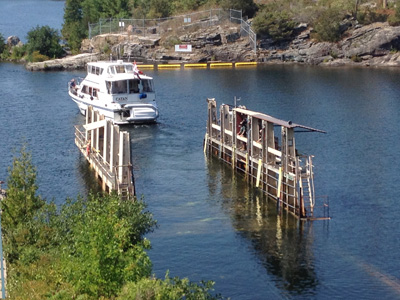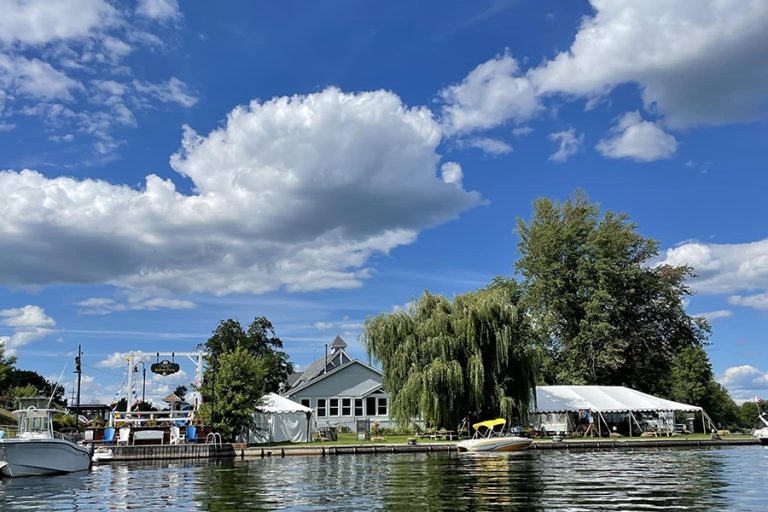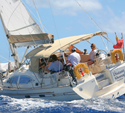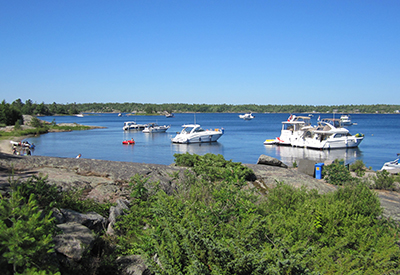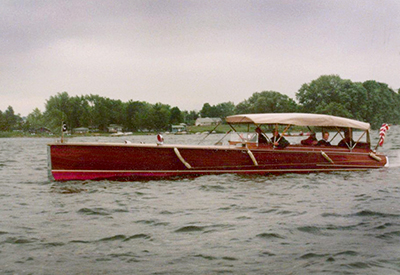Eleuthera Bound
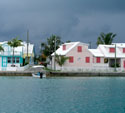
 It looked like we were floating in the world’s largest swimming pool. For as far as our eyes could see was the most beautiful sparkling clear water with no land in sight. It was a warm windless morning in early June and as we motor-sailed along over the glassy calm we could see bright red starfish slide by on the pure white sand bottom beneath us.
It looked like we were floating in the world’s largest swimming pool. For as far as our eyes could see was the most beautiful sparkling clear water with no land in sight. It was a warm windless morning in early June and as we motor-sailed along over the glassy calm we could see bright red starfish slide by on the pure white sand bottom beneath us.
We were heading north over the shallow sandy bank called Middle Ground that separates the Bahamian island groups of the Exumas to the south, where we had just spent the last few weeks, and our next destination, Eleuthera to the north.
Over the years, we have explored the Bahamas by boat on eight separate occasions and there are still places we haven’t seen. There are over over 700 islands and cays (pronounced “keys”) and the area compares in size to the entire chain of islands in the Caribbean Sea further south so like the Caribbean you can cruise for years here. This would be our first visit to the Eleuthera island group.
The main island of Eleuthera lies about 30 nm northeast of Nassau. It is a very long thin island running north-south, 90 miles in length and in most places only 2-3 miles wide, except at its south and north ends. Its coasts offer very little shelter; that is why it is best to visit here in calm settled weather that prevails in the spring and summer months. The surrounding reefs and shallow banks are also a deterrent but this means the fishing and diving are excellent which attracts intrepid fishers and divers in search of unspoiled environments. We were in the second category.
The main facilities for yachtsmen are found in the area of North Eleuthera in Spanish Wells on St. George’s Cay, an off-lying island to the west and home to a major Bahamaian offshore fishing fleet, and Dunmore Town on Harbour Island that lies to the east.
That morning we had been up at dawn to leave the anchorage at Hawksbill Cay in the Exumas. Although we were taking the shortest most direct route across the shallow banks to the north end of Eleuthera, we had a 55 nm voyage ahead of us and wanted to be sure we had good light for the whole trip. This route is strewn with numerous coral heads but with safe water in between, however you can’t see the heads in fading light or rainy conditions. The forecast was for clear skies.
There are alternative deep water routes coming in from the west from Nassau to the cut at Egg Island or to the east of Eleuthera from the deep water sound to the cut south of Dunmore Town on off-lying Harbour Island, but Paul and I enjoy testing our skills with challenging navigation and taking the route less travelled.
For most of the passage we had clear open water. The area most dense with coral heads is at the start of the route near Ship Channel Cay and Sail Rocks at the top end of the Exumas. But with the sun behind us, there was no glare on the water so we could easily see the heads and reef patches as dark splotches on the crystal blue sea and navigated between around them. We also were both wearing polarized sunglasses that further help reduce blinding reflection off the surface enabling you to see obstructions on the bottom even better.
Not only was this a test in navigation; it was a test in concentration. You can’t look away for a minute when navigating through reef-strewn areas so we stood formal 1-hour watches. When things got exciting, we both were on deck with eyes peeled.
“There’s Finlay Cay!” I pointed out a barren rocky islet that marks the halfway point across the banks to Current Island at North Eleuthera from Sail Rocks in the Exumas. “Be careful of the depths here. There’s a long sandy shoal that stretches out to the west in front of us.” We waved to a local fisherman anchored off the cay aboard “‘Bout Time”, the only other boat we’d seen all day.
We proceeded without difficulty for the rest of the day, taking our turns at watch and at slack tide (the current is strong on the banks). We dropped the hook for a lunch stop and snorkelled on an obscure reef patch in the middle of nowhere. It was rich in marine life with vividly colourful fans and corals and it was fun to think that, quite possibly, we were the first human beings to explore this tiny perfect reef.
Just as the sun began to get low in the summer sky, we dropped our 25-kilo Rocna anchor in a protected spot between Pimlico Islands and Current Island and called it a day. There wasn’t another soul or boat in sight.
Next morning we woke once again to sunshine but there was a breath of a breeze so poled out our 135% genoa and drifted our way further north to St. George’s Cay and the community of Spanish Wells, so named, apparently, when three centuries ago Spanish explorers stopped here to replenish their supplies declaring the well water here to be the best in the Bahamas.
As we entered the narrow harbour we passed rows of serious ocean-going fishing boats that lined the quay along the waterfront. The prosperity this fleet brings to the town (about 75% of the Bahamas annual production and export of lobster) is reflected in the number of new cars and large solid brightly painted homes with meticulous gardens. This was a real change from the charming yet ramshackle appearance of many of the small settlements we’d just visited in the Exumas.
The people of Spanish Wells are direct descendants of the Eleutheran Adventurers, a group of English religious dissidents who in 1648 left the island of Bermuda, then under the influence of the Anglican Church. The small group of Puritan settlers set out to found a new colony where they could freely practice their faith. They were shipwrecked on the island that was named Eleutheria after the group. It was later renamed Eleuthera, from the Greek word “freedom.” The group divided into fishers and farmers and Spanish Wells became the home of the fishing fleet. From what we could see The Puritan Work Ethic was still strong and thriving in the people of Spanish Wells.
There is a marina here, Spanish Wells Yacht Haven, with 40 transient slips that offers good facilities for both power and sailboat but we opted to pick up a mooring for $15 per night since the mooring field was more conveniently located off the main town dock close to shops and restaurants. Spanish Wells is a working town so a good place to pick up basic spares and supplies for the boat which we did at R&B Boat Yard and Spanish Wells Marine and Hardware. There is also an excellent large independently owned grocery store whose prices match mainland US prices, which is unheard of in the rest of the Out Islands we’ve visited. It’s a little out of town but we rented a golf cart for $40 for a couple days from Harbourside Golf Cart Rentals and used it to shop and explore.
The people of Spanish Wells are fiercely proud and self-sufficient yet friendly and welcoming to visitors, especially those arriving by boat. We’d only been ashore a short time when we were greeted by fisher, Roy Pinder, known locally as Crazy Roy. We asked him why.
“I got my head stuck in a shark’s mouth,” explained Roy with a grin and pointed out the scars around his face to prove it, “but I went right back to diving for lobster when I recovered. People said I was crazy.” He showed us a large shark’s tooth encased in gold that the he wears around his neck on a thick gold chain. “For good luck,” he winked.
From Spanish Wells our next destination was Harbour Island lying off the east coast of the main island of Eleuthera. To get there we had to take the channel over to the north end of Eleuthera known as the Devil’s Backbone. It is a treacherous path of reefs and shifting sandbars that has caught many ships in its grasp so it is highly recommended to hire a local pilot to take you through especially for first-timers. We thought it would be a great way to meet an interesting and knowledgeable local.
You can pick up your VHF radio and call “Pilot” and who ever’s available will respond. We had asked around and then gone through the list of names and numbers in the “Yachtsmen’s Guide to the Bahamas”.
“Here’s that guy named ‘Bandit’,” Paul pointed out. “Anyone with a nickname like that and the guts to advertise with it has to be worth meeting!”
So we called “Bandit” who turned out to be Jock Morgan, the same guy that manages the mooring field. We agreed to his price of $80 for the 9 nm or about 1.5 hour trip from Spanish Wells. He arrived at our boat at 1300 hours when the sun was high and, tying off his skiff to Distant Shores’ stern cleat so he could get home, he climbed aboard carrying a freshly baked loaf of bread sent by his wife as a gift. It was well worth the money. Not just for the peace of mind but the entertainment value. Jock is a great storyteller as well as a knowledgeable seaman and fisherman. When we arrived at the anchorage at Harbour Island we were sad to see him go.
The scene at Harbour Island is pretty different from Spanish Wells and we delighted in the contrast. This is a tourist and yachtmen’s paradise. Glistening sportfish and gleaming power yachts equipped with every imaginable convenience, bobbed gently in transient slips at the several marinas here. Sunbathing beauties lounged by sparkling swimming pools at the marina resorts. Visitors sipped on icy drinks and snacked on conch fritters at waterfront bars. Yet in the background were luxurious and brightly restored Loyalist homes. Dunmore Town on Harbour Island is one of the oldest established settlements in the Bahamas dating back to the 1700s when it was settled by British Loyalists and was the first capital of the Bahamas. Now it is a remote yet upscale boating destination with the most magnificent 3-mile long pink sand beach. We quickly got into the mood of lounging and schmoozing.
But hurricane season was approaching. The summer squalls were starting to roll in and it was time to say goodbye and head north to Annapolis, Maryland, and the safety of the Chesapeake Bay. We’d done 16,000 nautical miles in our Southerly 42 over the last few years and were now being lead into temptation. A new Southerly 49 had just been released and we’d put our money down (anyone interested in a well-equipped Southerly 42?) and the winds and tides of fortune were leading us to explore countries of Northern Europe next season. Stay tuned.


